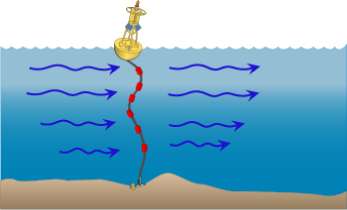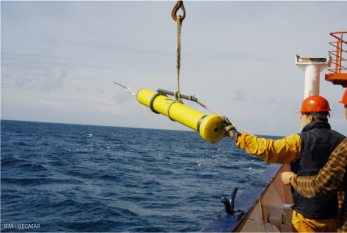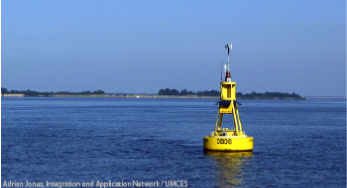How do scientists measure how the water is moving?
Imagine standing on a dock looking out at the ocean. You can see waves offshore, but you can't figure out which direction the water is moving. How would you figure this out? Scientists have pondered this same question and come up with two ways to follow water movement.

Fixed buoys are anchored to the bottom and remain in the same location while water moves past the buoy. The buoys are fitted with sensors that measure changes in speed, called an accelerometer. They are also fitted with an inclinometer, which measures the heaving motion of the water. A computer is onboard the buoys that interprets the data and transmits information on how fast waves are travelling, how tall the waves are (called wave height), and how far apart waves are spaced (called wave period). Sensors may also be located at various depths below the surface to collect information on water currents. Notice that fixed buoys are useful in observing what water is doing when it is flowing past the buoy, but does not tell us where the water is going. There are nearly 1,000 fixed buoys deployed in the global ocean. NOAA's National Data Buoy Center displays the vast network of buoys that are deployed around the world.
 Drifters go with the flow of water to track where it is flowing. Drifters have an internal GPS and transmit their location to satellites, which send the information to a main computer on land. Most drifters also collect information on temperature, which is useful to weather forecasters. Thousands of drifters have been deployed in the oceans and are constantly collecting and transmitting data. Some drifters can be programmed to alter their buoyancy (whether or not they float or sink) to collect information on deep water circulation. NOAA's Global Drifter Program website shows where the drifters are and the oceanic weather forecasts that are being generated from them.
Drifters go with the flow of water to track where it is flowing. Drifters have an internal GPS and transmit their location to satellites, which send the information to a main computer on land. Most drifters also collect information on temperature, which is useful to weather forecasters. Thousands of drifters have been deployed in the oceans and are constantly collecting and transmitting data. Some drifters can be programmed to alter their buoyancy (whether or not they float or sink) to collect information on deep water circulation. NOAA's Global Drifter Program website shows where the drifters are and the oceanic weather forecasts that are being generated from them.
